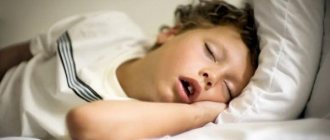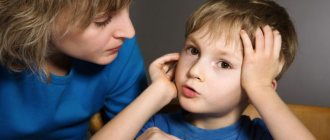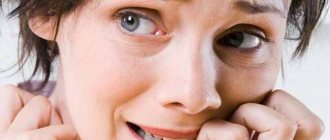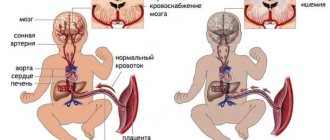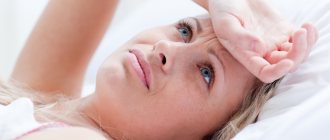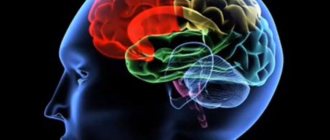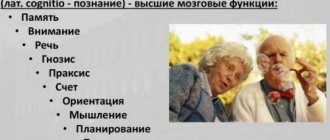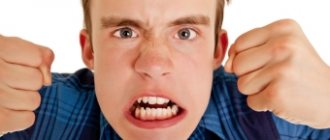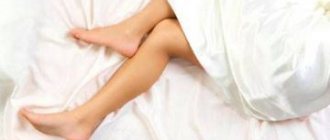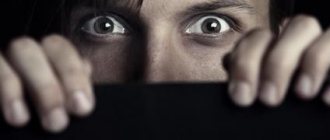If a child breathes intermittently during sleep, this may mean that he or she has sleep apnea - a temporary cessation of breathing that lasts more than 20 seconds. This is more common in premature babies and occurs during REM sleep (when the baby sleeps more soundly).
Sleeping baby
Important! Short pauses in breathing, lasting 5-10 seconds, are very often observed in newborns and are mostly not a pathology.
Causes
One of the ways to assess the level of functioning of the respiratory system is to count the frequency of its rhythm. Due to the special structure of the chest, the breathing of infants differs from that of adults; newborns show signs of arrhythmia.
In medicine, there is a special term for this phenomenon - periodic breathing. For babies who are not yet six months old, holding their breath is the norm. If the 6-month mark is long past and the problem remains, you should consult a doctor.
Periodic breathing accounts for 5% of the time a baby spends sleeping. If the mother had a premature birth, then this figure doubles.
The delay may be accompanied by a bluish discoloration of the skin around the mouth and bluish discoloration of the extremities. Such signs are quite common, but if the blueness spreads to the baby's forehead and body, this may indicate oxygen deficiency. The baby becomes lethargic and lacks breath.
If there is concern that the baby is not breathing, you need to wake him up with gentle touches. If there is no reaction, this may mean breathing has stopped, and an urgent call to the doctor is necessary.
The baby's intermittent breathing does not give cause for alarm. But children with repeated stoppages are at risk for complications and sudden death.
Rhythm disturbances may be accompanied by symptoms: whistling, wheezing, gurgling. These reasons for holding a child's breath during sleep are characteristic of infectious diseases. An increase in rhythm is one of the criteria for diagnosing pneumonia, which is often asymptomatic in children.
Children hold their breath and then pant rapidly if they have a fever. When shortness of breath is observed in parallel, these are signs of pulmonary or cardiac pathology that require hospital treatment of the patient.
Acceleration also occurs with false croup: the baby often coughs, exhaling air noisily. Attacks of obstruction during bronchitis occur with an acceleration of the breathing rhythm.
An increase in respiratory fluctuations that occurs during strong emotions or physical activity does not require observation. If the baby is interested in something and gets carried away, he may breathe frequently.
Running, jumping, outdoor games, and vigorous walking also speed up the breathing rhythm. If this rule is violated, the child must be examined.
Periodic respiratory counting is especially necessary in early childhood, when many pathologies are asymptomatic, and respiratory rate can become an important tool for identifying disorders in the early stages.
What to do if a child stops breathing?
Apnea in a child - first aid when breathing stops
First of all, urgently try to wake up the child. Let one parent begin to massage the baby's chest, and the second one calls an ambulance. Remember, seconds matter here! If the massage did not help within a minute until the ambulance arrived, start giving the baby mouth-to-mouth artificial respiration. At the same time, slowly and calmly inhale air into his open mouth, and to exhale, lightly press on his tummy. Dear mothers, if your baby shows signs of apnea, it is better to look for massage and artificial respiration techniques on video and master them in advance. And in any case, do not delay your visit to the doctor! Agreed? Health and happiness to you and your baby! Let him grow up strong, cheerful and smart!
Source: ritty.ru
Apnea
A pause in the breathing process during sleep is called apnea. Night apnea manifests itself in blueness, oxygen deficiency, and disruption of the cardiac system.
This situation threatens to turn off consciousness. If the victim is not provided with urgent qualified assistance, he may die. Deaths are most often reported at night, when it is more difficult to control the infant's breathing.
The causes of childhood apnea are problems with the central nervous system, overheating due to a violation of the thermal regime. If apnea is suspected, the frequency of breathing and the duration of pauses should be recorded. You should show your observations to your pediatrician, who will select a specific treatment.
There is a concept of sudden infant death syndrome, when infants unexpectedly die in their cradle. Heredity plays a big influence in this matter: according to statistics, brothers and sisters are at risk.
Special studies have shown that children with breathing pauses during sleep have difficulty waking up during the slow-wave sleep stage.
Why is sleep apnea dangerous?
As we have already said, the most dangerous consequence of apnea in a child is sudden death during sleep due to suffocation. In medicine, there is a term called SIDS - sudden infant death syndrome. Doctors make this diagnosis when, even during the autopsy, they do not find any visible cause of death of an apparently healthy child. At present, the fact has already been clearly established that 90% of physically normal babies who died in their sleep from unknown causes before reaching the age of one year in their sleep became victims of apnea syndrome.
First aid for difficulty breathing, coughing without stopping - Dr. Komarosky (video):
But other consequences of apnea in children that do not lead to death are little better. Let's take a closer look at the damage caused to the body, health and development of the baby by stopping breathing during sleep. First of all, this:
- Restless sleep, often interrupted by sudden, convulsive awakenings. After breathing stops during sleep, the brain receives a signal that the level of oxygen in the blood has dropped and oxygen starvation has occurred. A portion of adrenaline is released into the blood: the baby gets scared, snores sharply, wakes up and begins to breathe convulsively. Then he falls asleep again. Such sudden awakenings with advanced apnea in a child can be counted in up to a hundred cases per night. Moreover, most often in the morning the child usually does not remember that he woke up at night. The sleep disorder gradually takes on a chronic form and develops into insomnia.
- Constant night awakenings interfere with the child's rest, which is necessary for his full growth and development. Therefore, he does not get enough sleep, is capricious, constantly wants to sleep during the daytime, and his motor and mental activity decreases. As a result, physical inactivity develops and the child begins to gain weight.
- Children's snoring, the subsequent holding of breath, hypoxia and the release of adrenaline into the blood provoke sharp changes in blood pressure. Therefore, children with sleep apnea often develop cardiovascular diseases, hypertension, and arrhythmia.
- Insufficient oxygen supply to the brain at night interferes with the full development of the baby. His ability to concentrate decreases, his ability to learn decreases, and his character deteriorates.
- The inability to recover during sleep reduces the body's defenses. Therefore, against the background of apnea, the child’s immunity decreases and the susceptibility to various diseases increases, especially infectious and colds. Which in turn leads to increased manifestations of apnea symptoms.
- Apnea in newborns often leads to disturbances in physical development - the child begins to lag behind his peers in all respects.
As you have already seen, apnea in a child is a very serious problem. And our task, as parents, is to recognize the symptoms of apnea in time and begin treatment in a timely manner.
Prevention
To avoid the consequences of holding your breath, it is important to follow preventive measures:
- Regular ventilation of the room, comfortable temperature, humidity.
- Lack of a pillow in the baby's crib; do not place the baby on his stomach.
- Constant monitoring of the baby's health in the first year of life.
- If respiratory arrest is recorded, it is advisable to examine the baby in a hospital.
- It is important to fully treat colds, since they are often the cause of apnea.
- During routine examinations, it is necessary to inform the pediatrician of all the nuances of the baby’s well-being, including his complaints. To reassure you, you can do an ultrasound of the brain (Doppler).
- Only a doctor can give a correct assessment of the state of health after examining the respiratory tract and heart. Sometimes he recommends purchasing a ventilator.
Why does a child hold his breath in his sleep? The reason is a complete or partial obstruction that traps air and prevents it from entering the baby’s lungs. This leads to insufficient oxygen saturation of the blood and decreased muscle tone.
The list of obstacles can be continued with respiratory allergies, infections of the nose, ear, throat, and obesity. The appearance of obstructive sleep apnea syndrome is facilitated by the structural features of the nose and throat. Despite all the symptoms, diseases of the nervous and endocrine systems do not have a particular effect on the development of apnea.
Methods of treating apnea in children in modern medicine
Depending on the severity of the disease, the doctor prescribes a specific treatment method. It can be as simple as taking medications that stimulate the central nervous system, or it can be more serious.
- The first thing your doctor will advise you to do is to adjust your child’s diet. Make him lose a few kilos.
- The second is to get rid of the reasons that cause apnea.
For example:
- Remove tonsils.
- Try to cure anemia or arrhythmia.
- For reflux, normalize the consumption of cereals.
- Restore the functioning of the cardiovascular system.
- Widen your nostrils.
- Train the muscles of the mouth and pharynx.
- Try to correct the bite and lower the lower jaw using special devices.
In moderate cases, the doctor will prescribe CPAP therapy. This method of treatment is the most effective, but it should only be used as prescribed by a doctor. Therapy is carried out using a device in the form of a mask, which is put on the child. A special pressure is created in it, air enters in the required quantity through the tube. Typically, CPAP therapy alleviates the syndrome and children feel better. When using this method, babies do not have seizures.
In severe cases, when hardware treatment has failed, the doctor may prescribe a tracheostomy. This method is tough. The surgeon makes a hole in the trachea and inserts a tube through which the baby will breathe. The hole will be at neck level.
An important point is that the surgeon can also resort to other methods . For example, reducing the uvula, correcting the nasal septum, changing the lower jaw.
The site Colady.ru warns: self-medication can harm your health! The diagnosis should only be made by a doctor after an examination. Therefore, if you notice symptoms, be sure to consult a specialist!
All healthy children are able to hold their breath from birth. This natural reflex helps babies not to breathe under water, which is successfully used when teaching infants to swim. As we age, we learn to stop breathing when there are unpleasant odors or smoke. However, apnea, a type of sleep apnea, can be dangerous to the health and life of anyone.
Apnea in children: normal or a sign of disease?
The term "apnea" comes from the ancient Greek ἄπνοια - calmness. Meaning the absence of breathing movements, apnea saves you from trying to breathe underwater. However, stopping breathing during sleep is an unsafe phenomenon.
Apnea is characterized by the absence of attempts to breathe for 20 seconds or more. Holding your breath during sleep in adults for up to 20 seconds is considered a physiological norm. However, for children under one year old, due to the frequency of breathing, the delay should not exceed 10 seconds.
Apnea is not an independent disease; it is a symptom of certain pathologies of newborns, painful conditions and diseases. According to statistics, 2% of children have apnea of varying severity, caused by various reasons.
There are several types of apnea:
- central. With this type, there are no movements of the chest and abdomen, since there are no impulses from the central nervous system. The parts of the brain responsible for breathing do not do their job well;
- the obstructive type of apnea is characterized by the presence of attempts to inhale, but obstruction of the airways prevents the flow of air into the lungs;
- mixed type, when the pathology of the central nervous system is superimposed on the narrowing of the airways due to developmental characteristics or disease.
Different types of apnea can occur in children both while awake and during sleep. However, sleep apnea is more dangerous because it is less noticeable.
Apnea is the cause of death in 5-20% of sudden infant death syndrome (SIDS) cases. Although the etiology of SIDS is not well understood, this syndrome is the most common cause of death in newborns and children under 1 year of age.
There are a lot of diseases whose symptoms are apnea. The most common are:
- bacterial and viral infections;
- anemia;
- heart rhythm disturbances;
- pathologies of central nervous system development;
- epilepsy;
- hypotension;
- obesity;
- allergies that cause swelling of the nasopharynx, and other diseases.
Also, the appearance of apnea syndrome is influenced by prematurity, the use of certain drugs by the mother during pregnancy or by the child, pathologies of the structure of the nasopharynx, intrauterine infections, birth and postpartum injuries, and hereditary pathologies.
Sleep-disordered breathing: symptoms in children
Healthy sleep is the key to the proper development of a child. Prolonged and frequent pauses in breathing during sleep affect well-being, growth and can cause death. It is important to be able to distinguish the signs of apnea from minor breath holds.
Symptoms in children can be noticed both during sleep and during the day. A sleeping child should be alert to the following manifestations:
- frequent intermittent breathing;
- poor sleep;
- restless movements, muscle twitching;
- snore;
- lack of movement of the chest and abdomen for more than 10 seconds.
In severe cases, there is also cyanosis (cyanosis) of the skin, usually starting from the nasolabial triangle, slow pulse, and loss of consciousness.
With such symptoms, it is necessary to wake up the child, check whether the airways are free of foreign objects, vomit, mucus, massage the arms and legs, restoring blood circulation. In a difficult situation, you must immediately start artificial respiration, chest compressions and call an ambulance.
With sleep apnea, the following symptoms may appear during the day:
- drowsiness;
- restless, sometimes aggressive behavior;
- delayed growth and weight gain;
- slowdown in mental development.
Even infrequent apnea events that do not lead to a serious condition negatively affect the health and development of the child. Therefore, it is necessary to note deviations in the sleep process and report them to doctors in a timely manner.
Prevention and treatment of apnea
Prevention and treatment of apnea in children without developmental pathologies involves following the rules of a healthy lifestyle. The basic rules of prevention for children under one year of age are as follows:
- night sleep is preferable in a position on the side;
- the mattress in the crib must be dense and elastic; feather beds are strictly excluded;
- Children under one year old sleep without a pillow; to maintain hygiene, it is enough to place a folded diaper or pillowcase;
- sleepwear should be loose and not overheat the child;
- the room must be regularly ventilated.
Breastfeeding also helps prevent respiratory arrest by developing the baby's muscular system.
For infectious, bacterial diseases or allergies accompanied by vomiting, mucus secretion, hypertrophy of the tonsils, swelling of the nasopharynx and low-grade convulsions, children should be monitored from time to time during sleep. It is better if during such periods children sleep in the same room with their parents. Strengthening the immune system and timely treatment of such diseases, along with compliance with sleep rules, is the main prevention of apnea.
Treatment of diseases that cause apnea is a necessary condition for stopping cases of respiratory arrest. If a child has sleep apnea, a hospital examination is usually prescribed.
So that parents do not have to be on duty at the baby’s crib, there are special devices. The sensor of the device, placed in the bed, reacts to the child’s regular movements and gives a signal if breathing stops for more than 10 seconds.
In severe cases, children are recommended special masks to make breathing easier, or medications.
As the child grows, the chances of developing apnea decrease dramatically.
There is no need to concentrate too much attention, listening and peering at the baby’s movements all night long; such behavior can lead to neurosis-like states in the parents and negatively affect the child. Severe apnea in childhood is extremely rare. Slow or rapid breathing, pauses of up to 10 seconds - all these are phenomena of the physiological norm. And prevention and adherence to sleep rules will help avoid the main causes of respiratory arrest.
Today, dear mothers, we will talk to you about a very insidious illness that affects many babies under one year old. This is sleep apnea , or sudden cessation of breathing during sleep. It is apnea in children that is one of the main causes of sudden child death (SIDS), from which children who are apparently completely healthy sometimes die. This disease develops slowly and imperceptibly, so our task is to diagnose apnea in a timely manner and treat it.
Snore
Many babies with delay symptoms also snore – intermittently and quite loudly. Pauses during breaks can be up to 30 seconds. Such children sleep restlessly: they cry out, wake up, rush around in bed, and fall asleep again in the most atypical position - head down.
At an unconscious level, they are trying to get rid of the obstacle that makes it difficult for air to enter the lungs. With such a problem, the deep sleep phase is practically inaccessible to them.
If your baby makes different sounds in his sleep, you can check with your pediatrician about the optimal sleep position for him. Often mucus collects in the baby's nasopharynx, causing snoring.
Unclear breathing is caused by bronchiolitis, a viral infection that fills the spaces in the lungs with mucus. A snoring child, entertaining and touching his parents, causes horror among doctors.
One of the reasons for children's snoring is the new fashion for conservative treatment of tonsils. A specific children's menu (soda, chocolate, fast food) is another cause of sleep disturbance.
Establishing diagnosis
Making a diagnosis begins with parents identifying the problem. The following symptoms should raise suspicion:
- restless and interrupted sleep;
- baby's moodiness;
- loss of appetite;
- lethargy and drowsiness during the daytime.
If these signs occur, parents should immediately consult a doctor. The first action of a specialist is a thorough study of all the diseases that the baby has suffered from. In addition, heredity is subject to detailed analysis.
Then comes the assessment of body weight and the cervical spine weight index. Also, in some cases, you may need to consult a cardiologist, neurologist and otolaryngologist. The fact is that in some cases, symptoms such as weakness and difficulty breathing through the mouth also occur with adenoids.
What to do
If pauses in breathing during sleep exceed 15 seconds, it is necessary to urgently prepare the baby for hospitalization. Before the ambulance arrives, the baby must be given cardiopulmonary resuscitation so that the baby can breathe again.
Every sixth child today has sleep problems. The baby may be bothered by insomnia and drowsiness, nightmares and enuresis, headache and weather dependence, dry mouth and increased sweating, motor disinhibition and fatigue, snoring and apnea.
All of the listed problems that negatively affect the baby’s body are associated with the characteristics of his breathing. Expert opinion on new methods of treating childhood sleep disorders in this video
Experts call walking or singing at night in children 2-4 years old the norm; the main thing is to protect such a child while sleeping, without putting him on the top floor of a bunk bed.
Polysomnography, a method for studying the sleep process, will help exclude childhood epilepsy and other serious disorders. 18 sensors monitor all processes in the body: heart rhythm, breathing rate, brain function. By the age of 2 and a half, attacks of respiratory arrest usually stop, but sometimes persist up to 6 years.
Signs of sleep apnea in children - how is it diagnosed?
Symptoms:
- Snore. Children can snore very loudly.
- Breathing through the mouth, even if there is no nasal congestion.
- Grinding your teeth in your sleep.
- Shortness of breath, breathing with pauses.
- Fatigue. The baby may get tired more often and ask to sleep.
- The skin has a pale, bluish tint.
- The child often turns over in his sleep.
Parents are advised to watch their baby while he sleeps. Most often, the syndrome occurs in the morning, when children are not sleeping soundly. If you notice restless sleep and some other signs, contact your doctors - pediatrician and ENT specialist. They will either justify your suspicions or find another reason for the baby’s anxiety in his sleep.
When diagnosed, children will have to undergo several laboratory tests:
- A general blood test, as well as a blood test for the amount of oxygen, sugar content, and bacterial infection.
- Cranial ultrasound.
- Electrocardiogram.
- X-rays: chest organs, respiratory tract.
- EEG during sleep and wakefulness.
- Pneumography.
Unfortunately, not all hospitals have the necessary equipment, so many parents who are faced with a problem turn to private clinics. Doctors use the most modern and effective diagnostic method, called polysomnography .
It is carried out in a hospital. Parents and their baby come to the clinic and stay overnight. During the study, doctors conduct the necessary tests and monitor the child’s sleep, breathing, eye movements, brain radiation, snoring and other important indicators.
Based on the diagnostic results, doctors will determine whether the child has apnea. Usually conclusions are made based on what symptoms appear.
They are divided into three categories:
- Frequent. These include: snoring, restless sleep, daytime drowsiness, irritability, apnea attacks. Such symptoms occurred in 60% of children studied.
- Less frequent , occurring in 10-60% of children. These include sweating, headache, and asthma attacks.
- Rare. Your baby may suffer from insomnia, cough, and reflux. These manifestations do not appear in all children, for example, in newborns.
If you do not have the opportunity to undergo diagnostics under the supervision of a sleep specialist, you can perform polysomnography at home. For this purpose, the child can be connected to a cardiorespiratory monitor. He is able to record the baby's breathing rate and monitor how his heart works. This device can be used for several months.
Measuring respiratory rate for children
In infants, breathing is shallow, jerky, with an alternately slowing and accelerating rhythm. Uneven breathing is normal for a newborn baby - both for those born on time and for those who are premature.
Calculate the baby's breathing rhythm when he is absolutely calm. In infants, it is convenient to observe the chest. To listen to breathing, doctors use a phonendoscope, but if you simply put your hand on the child’s chest, you can record all its fillings.
The baby must be distracted so that he does not get scared and interfere with the counting. The norm for infants up to one year old will be 50-60 sighs per minute, from one year to 3 - 30 sighs, 4-6 years - 25. With the number of sighs significantly exceeding the norm, we can conclude that there is shallow breathing with all the ensuing consequences.
Breathing is one of the main vital functions of a person. If it seems completely ordinary, it’s worth hiding it for half a minute to realize its true value.
Holding your breath and oxygen starvation can cause another delay - in development. This is expressed in hyperactivity and attention deficit disorder. The baby is unable to sit still and cannot perceive information. All this creates problems with his education, the child grows up mentally retarded.
Symptoms of the disease
In order to promptly detect and eliminate nocturnal breathing pauses in infants, parents need to monitor the quality of rest and sleep behavior. In addition, knowledge of symptoms will help to identify the problem in a timely manner, namely:
- during a sound sleep, the child holds his breath for more than 10 seconds;
- snoring appeared;
- the baby breathes through his mouth;
- Anxious behavior is observed during sleep;
- there is strong sweating;
- periodically during the daytime the baby complains of a headache;
- developmental delay.
Important: The first sign of an attack is the child’s face and fingertips turning blue. In addition, there is a weakening of muscle tone, and the pulse gradually slows down.
During an attack of apnea in newborns, hypoxia occurs. This provokes waking up. In addition, older children may become frightened due to the release of adrenaline into the blood. Against this background, appetite may worsen and developmental delay may occur.
Preventive actions
So, we looked at why apnea occurs and how to overcome this pathology. It remains to summarize and note that it is much easier to prevent the development of this most dangerous condition. To do this, follow these tips:
- put the baby on his side to sleep;
- use bedding made from natural fabrics;
- purchase an orthopedic mattress;
- Ventilate the room more often and do not wrap your baby up.
Teach your children from a young age to lead a healthy lifestyle and then such a dangerous disease as apnea will not bother your family.
Source: ZdoroviySon.com
Diagnosis of breathing disorders
First of all, parents can determine the presence of apnea. Observe your baby's breathing at the beginning of sleep and from 4 to 6 am. If you hear snoring, whistling, or sobbing, you should consult your pediatrician.
If breath holding is detected, it is recommended to use a stopwatch to measure the duration of one episode of apnea. If the child stops prematurely for 10 seconds or more, the child must be examined. The pediatrician should refer you to an otolaryngologist,
cardiologist, neurologist and surgeon. Specialists study the medical history, features of the course of pregnancy and childbirth.
For an accurate diagnosis, polysomnography is prescribed. This technique allows you to determine the cause of the development of any sleep disorders. Also, after consultation with a surgeon, the child may be sent for an X-ray of the skull, which reveals congenital or acquired pathology in the structure of the nasal passages.
What are the possible consequences of pathology?
The consequences of such a pathology result in dangerous complications, especially when it comes to one-year-old children. In this condition, against the background of oxygen deficiency, the following defects develop:
- Children often develop hyperactivity;
- the inability to concentrate is formed;
- pathological conditions of the heart muscle;
- increased drowsiness and arrhythmia;
- natural development and growth slows down.
In addition, at an advanced stage, there is a high risk of developing ischemic pathology, heart attack and stroke due to disruption of the heart muscle. Also, children suffering from short-term breath holdings are more susceptible to various injuries.
Parents' actions during an attack
Holding your breath at night in children of all ages can cause asphyxia. And this condition is already fraught with death. In view of this, parents need to know how to behave when such a condition is detected. So, when you urgently need to call emergency services:
- slow pulse, less than 90 beats;
- the appearance of a bluish color in the area of the wings of the nose, around the mouth and on the limbs;
- involuntary drooping of limbs.
Important: To prevent breathing from stopping, it is recommended to thoroughly ventilate the baby’s bedroom, prevent overheating of the newborn by excessively wrapping it, and try to take air baths as often as possible.
In addition, before emergency assistance arrives, parents must do the following:
- perform artificial respiration;
- put the baby in a horizontal position;
- examine the tongue for retraction;
- take the mouth with your fingers, cover the nose and blow air until the child begins to move in the chest area.
If there is no pulse, mom or dad should perform a heart massage while simultaneously breathing air into the baby's mouth. The massage is performed until the doctor arrives.

